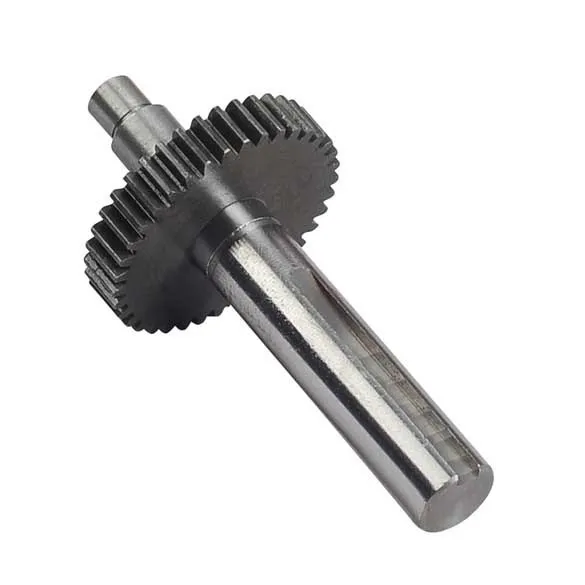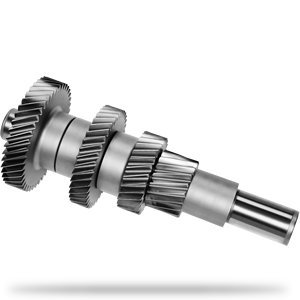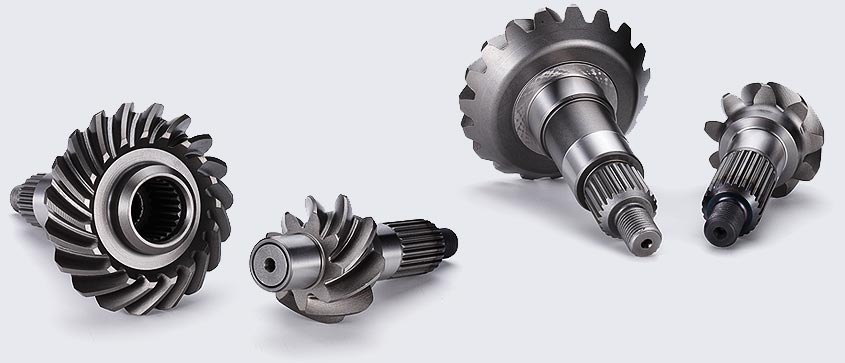Product Description
Involute Gear shaft for Reducer
1. Description
| No. | Item | Description |
| 1 | Name | Spiral teeth-Gear Shaft |
| 2 | Size | Products can be customized. |
| 3 | Manufacture Standard | 5-8 Grade ISO1328-1997. |
| 4 | Material | 45#Steel,20CrMnTi,40Cr,20CrNiMo,20MnCr5,GCR15SiMn,42CrMo,2Cr13stainless steel,Nylon,Bakelite,Copper,Aluminium.etc |
| 5 | Production Process | The main process is Gear Hobbing and Gear Grinding, Selecting production process according to the different products. |
| 6 | Heat Treatment | Carburizing and quenching ,High-frequency quenching,Nitriding, Hardening and tempering, Selecting heat treatment according to the different materials. |
| 7 | Testing Equipment | Rockwell hardness tester 500RA, Double mesh instrument HD-200B & 3102,Gear measurement center instrument CNC3906T and other High precision detection equipments |
| 8 | Certification | GB/T19001-2016/ISO9001:2015 |
| 9 | Usage | Used in printing machine, cleaning machine, medical equipment, garden machine, construction machine, electric car, valve, forklift, transportation equipment and various gear reducers.etc |
| 10 | Package | According to customer’s request |
2. Photos
3. Order process
a. Customer sends us the drawing or sample, If only sample, our company supply the CAD drawing.
b. Our company supplies the processing technique and quotation.
c. Our company supplies the sample after customer confirmed processing technique and quotation.
d. Customer places the order after confirm the sample.
e. Customer pay 50% deposit
f. Quantity production.
g. Pay the balance after the acceptance and confirmation.
h. Delivery.
| Application: | Motor, Electric Cars, Motorcycle, Machinery, Marine, Toy, Agricultural Machinery, Industry |
|---|---|
| Hardness: | Hardened Tooth Surface |
| Gear Position: | External Gear |
| Manufacturing Method: | Gear Hobbing and Gear Grinding |
| Toothed Portion Shape: | Involute |
| Material: | 45#Steel,20crmnti,40cr,20CrNiMo,20mncr5,Gcr15simn, |
| Customization: |
Available
| Customized Request |
|---|

Can gear shafts be used in precision machinery and equipment?
Yes, gear shafts are commonly used in precision machinery and equipment. Precision machinery requires high accuracy, reliability, and smooth operation, and gear shafts play a critical role in achieving these requirements. Let’s explore the reasons why gear shafts are suitable for precision machinery:
- Power Transmission:
Gear shafts are essential components for transmitting power between various components in precision machinery. They enable the transfer of rotational motion and torque from the input source to the desired output, allowing the machinery to perform its intended function precisely and efficiently.
- Precise Positioning and Control:
Gear shafts, along with gears and other related components, enable precise positioning and control in precision machinery. By utilizing carefully designed gear ratios and configurations, gear shafts can accurately control the speed, direction, and timing of movements within the machinery. This precision is crucial in applications such as robotics, CNC machines, and other automated systems.
- Load Distribution:
In precision machinery, gear shafts help distribute loads evenly across various components. By utilizing multiple gears and shafts, the transmitted load can be distributed over a larger surface area, reducing stress concentrations and minimizing the risk of premature wear or failure. This load distribution capability is vital in maintaining the integrity and longevity of precision machinery.
- Backlash Control:
Backlash refers to the slight clearance or play between meshing gears. In precision machinery, it is crucial to minimize or control backlash to ensure accurate and repeatable movements. Gear shafts, when properly designed and manufactured, can contribute to minimizing backlash by maintaining precise gear meshing and reducing any unwanted movement or play between the gears.
- High Torque Transmission:
Precision machinery often requires the transmission of high torque while maintaining accuracy and reliability. Gear shafts are capable of handling high torque loads and transmitting power efficiently. They are designed to withstand the forces and stresses associated with high torque applications, ensuring reliable operation and minimizing power losses.
- Customization and Adaptability:
Gear shafts can be customized and adapted to meet the specific requirements of precision machinery. They can be manufactured with various materials, such as steel or specialized alloys, to achieve the desired strength, durability, and dimensional accuracy. The gear profiles, shaft dimensions, and other parameters can be tailored to suit the particular application, allowing for optimal performance and compatibility within precision machinery.
- Reliability and Longevity:
Gear shafts are known for their reliability and long service life when properly designed, manufactured, and maintained. They are subjected to rigorous quality control measures to ensure dimensional accuracy, surface finish, and appropriate hardness. This focus on quality and precision results in gear shafts that can withstand demanding operating conditions and provide consistent performance over an extended period.
In summary, gear shafts are indeed suitable for use in precision machinery and equipment. Their ability to transmit power, enable precise positioning and control, distribute loads, control backlash, handle high torque transmission, offer customization options, and provide reliability and longevity make them essential components in achieving the accuracy and performance required by precision machinery.

What are the factors to consider when designing gear shafts for specific applications?
Designing gear shafts for specific applications requires careful consideration of various factors to ensure optimal performance and reliability. Let’s explore the key factors that should be taken into account during the design process:
- Load and Torque Requirements:
The load and torque requirements of the specific application are crucial considerations. Understanding the maximum load the gear shaft will experience and the torque it needs to transmit is essential for selecting appropriate materials, determining the required dimensions, and ensuring the gear shaft can handle the anticipated forces effectively.
- Gear Type and Configuration:
The gear type and configuration directly influence the design of the gear shaft. Different gear types, such as spur gears, helical gears, bevel gears, or worm gears, have unique characteristics that impact the design considerations for the gear shaft. Factors such as gear tooth profile, pitch, pressure angle, and gear ratio need to be taken into account during the design process to ensure proper alignment, engagement, and efficient power transmission.
- Material Selection:
Selecting the appropriate material for the gear shaft is crucial for its strength, durability, and performance. Factors such as the required strength, wear resistance, fatigue resistance, and corrosion resistance should be considered when choosing the material. Common materials for gear shafts include various steels, alloys, and sometimes specialized materials like bronze or brass, depending on the specific application requirements.
- Shaft Dimensions and Geometry:
The dimensions and geometry of the gear shaft need to be carefully determined. Factors such as shaft diameter, length, keyways, chamfers, and fillets are important considerations. Proper shaft dimensions and geometry ensure sufficient strength, proper fit within the gear assembly, and compatibility with other components within the system.
- Bearing Support and Lubrication:
The gear shaft design should incorporate provisions for bearing support and lubrication. Bearings placed along the gear shaft help reduce friction, support the shaft under load, and ensure smooth rotation. Adequate lubrication, such as oil or grease, is necessary to minimize wear between the gear shaft and bearings, as well as to reduce heat generation and promote efficient operation.
- Heat Treatment and Surface Finish:
Depending on the application requirements, heat treatment processes like quenching and tempering may be applied to enhance the mechanical properties of the gear shaft. Heat treatment can improve hardness, strength, and toughness, increasing the gear shaft’s ability to withstand high loads and resist wear. Additionally, considering the surface finish of the gear shaft can help reduce friction, improve gear meshing, and minimize the risk of surface damage.
- Manufacturability and Cost:
Designing gear shafts should also take into account manufacturability and cost considerations. The design should be feasible for manufacturing processes such as machining, forging, or casting, depending on the chosen material and complexity of the design. The design should also aim to optimize material usage and minimize manufacturing costs while meeting the required performance criteria.
In summary, when designing gear shafts for specific applications, factors such as load and torque requirements, gear type and configuration, material selection, shaft dimensions and geometry, bearing support and lubrication, heat treatment and surface finish, as well as manufacturability and cost considerations, should all be carefully evaluated. By considering these factors, a well-designed gear shaft can be developed to meet the specific needs of the application, ensuring reliable and efficient power transmission within the gear system.

What is a gear shaft and how does it function in mechanical systems?
A gear shaft is a key component in mechanical systems that transmit rotational motion and power between gears. It acts as a mechanical linkage, connecting two or more gears and enabling the transfer of torque and rotational speed. Here’s how a gear shaft functions in mechanical systems:
- Power Transmission:
A gear shaft serves as a means of power transmission between gears. When one gear is rotated, either by an input source or another gear, the gear shaft transmits the rotational motion to the connected gear or gears. This allows for the transfer of power from one gear to another, resulting in the desired mechanical output.
- Support and Alignment:
A gear shaft provides support and alignment for the gears it connects. It is typically mounted on bearings or bushings within the mechanical system, allowing it to rotate smoothly. The bearings help reduce friction and wear, ensuring efficient power transmission and prolonging the lifespan of the gears and the shaft.
- Torque Transmission:
In addition to transmitting rotational motion, a gear shaft also transmits torque. Torque is the rotational force that causes an object to rotate. As a gear shaft connects gears with different sizes or numbers of teeth, it allows for torque multiplication or reduction, depending on the gear ratios. This enables mechanical systems to achieve the desired speed and torque requirements for specific applications.
- Speed Control:
The gear shaft, along with the gears it connects, plays a crucial role in controlling rotational speed. By using gears with different sizes or ratios, the gear shaft can increase or decrease the rotational speed of the output gear compared to the input gear. This speed control capability is essential in various applications, such as adjusting the speed of machinery or enabling different speed settings in vehicles.
- Directional Change:
Another function of a gear shaft is to change the direction of rotational motion. By using gears with specific tooth profiles and arrangements, the gear shaft can redirect the rotational motion by 90 degrees or any desired angle. This directional change allows mechanical systems to transmit motion and power efficiently in different orientations, enabling complex machinery and mechanisms.
- Load Distribution:
A gear shaft helps distribute the load evenly among the connected gears. As the gears engage with each other through their teeth, the gear shaft ensures that the force and torque applied to one gear are evenly transferred to the others. This load distribution minimizes excessive stress on individual gears, promotes smooth operation, and enhances the overall durability and reliability of the mechanical system.
In summary, a gear shaft is a critical component in mechanical systems that facilitates power transmission, torque transfer, speed control, directional change, load distribution, and alignment of gears. Its proper design, installation, and maintenance are essential for efficient and reliable operation of various machinery and mechanisms.


editor by CX 2023-09-21